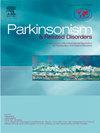Atypical ADCY5-related movement disorders: Highlighting adolescent/adult-onset cervical dystonia
IF 3.1
3区 医学
Q2 CLINICAL NEUROLOGY
引用次数: 0
Abstract
Background
ADCY5-related movement disorders are typically paroxysmal dyskinesia (PxDs) and/or static hyperkinetic movement disorders. Nocturnal paroxysmal dyskinesia (PxD), facial or perioral dyskinesia are suggestive of this genetic diagnosis. Next generation sequencing has enabled an expansion of the ADCY5- related phenotype.
Objective
The aim of our study was to report atypical phenotypes.
Results
We describe 13 patients from 8 different families, of which 10 had adolescent/adult-onset head and upper limb tremor followed by static cervical dystonia without PxD. We report three novel ADCY5 variants in these patients, located in the catalytic domains, close to previously reported variants. Caffeine was ineffective for the 3 patients who tried the treatment, and botulinum toxin therapy seemed to be the most effective treatment. We also describe 2 patients with spontaneous remission of pediatric-onset PxD before adulthood.
Conclusion
We highlight an adolescent/adult-onset phenotype with head tremor and cervical dystonia, widening the genetic spectrum of cervical dystonia. Moreover, we broaden the pediatric ADCY5-PxD phenotype, highlighting previously unreported cases of spontaneous remission.
求助全文
约1分钟内获得全文
求助全文
来源期刊

Parkinsonism & related disorders
医学-临床神经学
CiteScore
6.20
自引率
4.90%
发文量
292
审稿时长
39 days
期刊介绍:
Parkinsonism & Related Disorders publishes the results of basic and clinical research contributing to the understanding, diagnosis and treatment of all neurodegenerative syndromes in which Parkinsonism, Essential Tremor or related movement disorders may be a feature. Regular features will include: Review Articles, Point of View articles, Full-length Articles, Short Communications, Case Reports and Letter to the Editor.
 求助内容:
求助内容: 应助结果提醒方式:
应助结果提醒方式:


